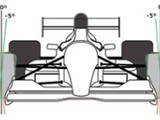Adding Negative Camber to the Front or Rear of the MINI – is it for Everyone? Pros and Cons
By: Nathan Neudecker
As far as front-wheel drive cars go, the MINI Cooper is a bargain in terms of “out-of-the-box” handling. Time and time again, automotive journalists have heralded the MINI as fun, neutral, and well-balanced. These are all true statements, but the fact remains that there is a lot of untapped potential that can be exploited through a proper wheel alignment; specifically, adding negative camber.

Camber is best described as the angle the tire slants from vertical, when viewed directly from the front or rear of the vehicle. Negative camber is when the top of the tire slants inwards, towards the center of the car. As with any other modification that can be made to your MINI, adding negative camber is a trade-off.
Image via TireRack
Pros
When cornering hard in your MINI, the suspension geometry will change, causing the outside tires to “lean” outwards, reducing the tire contact patch. By adding negative camber, the contact patch of the tire will be larger when it “stands up” under cornering forces. This increases lateral grip, ultimately allowing for higher cornering speeds and faster lap times on the track.
The MINI Cooper, being a lightweight front-wheel drive car, responds well to more negative camber in the front than in the rear. This allows for a more neutral feel when cornering hard, reducing understeer felt with factory specs.Personally, I run -2.3° F, -1.7° R; this is a fairly aggressive setup for a street car. Since I am not concerned with tire wear, this setup allows for a very neutral feel when cornering under constant throttle, and a slight amount of oversteer when letting off the throttle. Having the ability to tailor the handling characteristics of your MINI is the biggest advantage to running negative camber.
Cons
As previously stated, running negative camber is a trade-off. By increasing the amount of negative camber on your MINI, you risk increased tire wear and some adverse handling characteristics when driving on uneven pavement.Since negative camber causes an inward thrust force, driving on uneven pavement may cause some “darting”. This is exaggerated depending on the amount of negative camber. If you are willing to deal with the occasional darting and leave your “toe” set as close to zero as possible, the increased tire wear from negative camber isn't very significant. Linear acceleration and hard-braking could be affected when running negative camber; however, I find the MINI doesn't make enough power to make traction an issue, and it's light-weight ensures quick braking, regardless of negative camber.
Is Negative Camber for Me?
If you only use your MINI as a commuter on the freeway, you would not want to add any negative camber. If you are reading this article, chances are you are just like me; enthusiastic daily driving with the occasional autocross/track day. If you land in this category, you will greatly benefit from the addition of negative camber to your MINI.
In order to adjust camber on your MINI, you will need to invest in a set of Camber Plates for the front, and a pair of adjustable Lower Control Arms for the rear. If you are lowering your MINI, adding the camber plates and control arms will prove invaluable during your alignment. Lowering your MINI will add negative camber naturally, so having the ability to compensate for this is very important if you want to retain those “well-balanced” handling characteristics.








